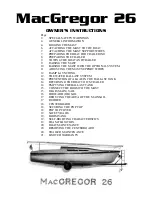
Skiing or Riding:
The watercraft and skier/rider should
always maintain a sufficient distance from obstacles so a
skier/rider falling or coasting and/or watercraft will not
encounter any obstacle.
Do not use in shallow water or near shore, docks, pilings,
swimmers, other watercraft, or any other obstacles.
Use only on water.
Never attempt land or dock starts. This will increase your
risk of injury or death.
Always wear a properly fitted life jacket (PFD) approved by
your country’s agency, USCG Type III, ISO, etc.
The faster you ski or ride, the greater your risk of injury.
Never make sharp turns that may cause a slingshot effect
on the skier/rider’s speed.
Skier/Rider should be towed at an appropriate speed for
their ability level.
Fallen skier or rider:
Falling and injuries are common in
skiing or riding.
Circle a fallen skier/rider slowly to return the tow rope
handle or pick up the fallen skier/rider.
Put the watercraft in neutral when near a fallen skier/rider.
Always keep the fallen skier/rider in view and on the driver’s
side of the watercraft.
Display a red or orange skier/rider down flag to alert other
vessels that a skier/rider is down.
The Warnings and practices in the Watersports Safety
Code represent common risks encountered by users.
The code does not cover all instances of risk or danger.
Please use common sense and good judgment.
BOATING SAFETY
SECTION 2
2-47
When participating in watersports, be safe and courteous
and follow these guidelines:
Be considerate to fishermen and others you share the water with.
DO NOT perform watersports in congested areas.
Stay away from navigation markers.
Stay away from other boats and watersports participants.
BASIC RULES ON THE ROAD
The nautical rules of the road must be followed to prevent
collisions between vessels. Like traffic laws for automobiles,
the operator is legally required to follow the rules.
The following information outlines only the most basic
of the nautical rules of the road. For more information,
contact your local U.S. Coast Guard Auxiliary or local
maritime authority.
The operator is legally required to follow the rules. The
following information outlines only the most basic of the
nautical “Rules of the Road.” For more information, contact
your local USCG Auxiliary.
Aids to Navigation
Learn to recognize the different buoys and day markers;
they are the signposts of the waterways. The United
States Aids to Navigation System (USATONS) is the primary
marking system used on inland water, coastal waters and
rivers in the United States. This system is maintained by the
U.S. Coast Guard (USCG).
2-48
Summary of Contents for 2015 ASR
Page 1: ...2015 OWNER MANUAL ...
Page 4: ...SECTION 1 ...
Page 14: ...INTRODUCTION 1 19 SECTION 1 EUROPEAN SEATING CHART 1 20 ...
Page 15: ...1 21 1 22 ...
Page 16: ...1 23 1 24 ...
Page 17: ...SECTION 2 ...
Page 46: ...SECTION 3 ...
Page 60: ...SECTION 4 ...
Page 74: ...SECTION 5 ...
Page 80: ...BOAT SYSTEMS SECTION 5 5 11 5 12 ...
Page 81: ...SECTION 6 ...
Page 96: ...TROUBLESHOOTING SERVICE REQUIREMENTS SECTION 7 ...
Page 98: ...TROUBLESHOOTING SERVICE REQUIREMENTS SECTION 7 7 3 7 4 ...
Page 99: ...TROUBLESHOOTING SERVICE REQUIREMENTS SECTION 7 7 5 7 6 ...
Page 100: ...TROUBLESHOOTING SERVICE REQUIREMENTS SECTION 7 7 7 7 8 ...
Page 101: ...TROUBLESHOOTING SERVICE REQUIREMENTS SECTION 7 7 9 7 10 ...
Page 102: ...TROUBLESHOOTING SERVICE REQUIREMENTS SECTION 7 7 11 7 12 ...
Page 103: ...TROUBLESHOOTING SERVICE REQUIREMENTS SECTION 7 7 13 ...
Page 104: ...WARNING LABELS SECTION 8 ...
Page 107: ...WARNING LABELS SECTION 8 8 5 8 6 ...
Page 108: ...WARNING LABELS SECTION 8 8 7 8 8 ...
Page 109: ...WARNING LABELS SECTION 8 8 9 8 10 ...
Page 110: ...WARNING LABELS SECTION 8 8 11 8 12 ...
Page 111: ...WARNING LABELS SECTION 8 8 13 8 14 GOOD BAD ...
















































